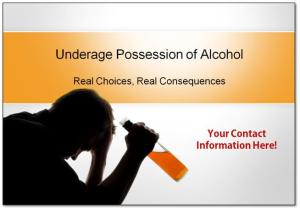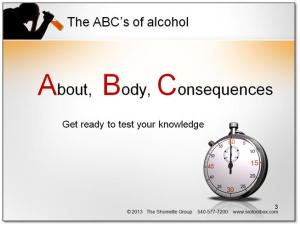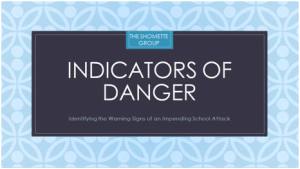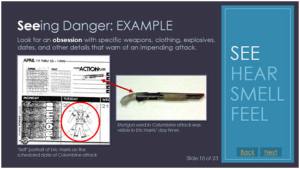An Easy and Effective Way to Get Your Students to Play Their Part in School Safety
December is a perfect (and necessary) time to reach out to your students and to remind them of the part they must play to help make our schools safer (no place can be completely safe—only safer).
To help you achieve this goal, I’ve created everything you’ll need from what to say to the students to a letter to send to the parents. I guarantee that if you do this very simple thing, you’ll make an immediate difference in the safety of your school.
Here’s what we’re going to do. We’re going to tell the students when and how to report a threat with one simple sentence.
“Tell the first adult you see if you’re afraid for your safety or the safety of others.”
Before we get into the easy ‘how’ here is the simple ‘why’.
We know that in approximately 75% of previous school attacks someone (most often a student) has known about the attack before it occurred. I think it’s 100%. We must reach out to our students this month and get them to do their part, especially now since December is an increased threat time for a school attack (second only to March-April). It is a tragedy that so many school attacks could have been prevented if a student would have just come forward and that we adults don’t encourage and equip the students to do so.
I’ve created a script that you can use to encourage students to come forward. It’s easy and takes only a few minutes. While there’s several different ways you can deliver the message (we’ll get to those next), the script will basically be the same for any delivery method you choose. Feel free to modify the script as needed.
Let’s take a look at the script:
Good morning.
I’m going to be talking with you about a subject that is very important and that subject is teamwork (or you can use safety, friendship, good citizenship, etc.). Teamwork enables a group of people committed to the same goal to be more successful by working together than if they went at it alone. As a school, we have lots of goals. We want to be successful in learning, music, arts, sports, and many other things. But to be successful in these goals we have to be a team, to look out for each other, and to work together. Making our school safer also requires us to be a team. We must work together and each person must do their part. Your part is to be a good friend and to look out for each other.
How do you do that? Simple.
Tell the first adult you see if you’re afraid for your safety or the safety of someone else.
Do not come and try to find me. I may be tied up with something. If you tell the first adult you see, they will know how to get a hold of me.
When you tell an adult that you’re afraid for your safety or the safety of someone else, they’ll tell me and I’ll talk to the person you’re trying to help and then I’ll try to help them as well. It’s that simple.
We don’t want anyone to hurt themselves or someone else and that’s our goal. To help everyone be safe, I’ll need your help. I need you to be a member of the team. If you’re willing to do that, please take out a piece of paper and sign the sheet with your name. Then, write a huge teamwork on it and pass it up. I want to keep these because it matters. You matter.
Thanks and be a good friend today.

Here’s a couple of easy delivery methods you can choose from to prepare the students.
1. Visit the classrooms
2. Have the teachers do it
3. Hold an assembly
4. Read it over the PA system
Method 1: Visit the classrooms:
This is my personal favorite, but you’ll briefly interrupt the academic process. What I like about this method is that it’s quick (I’ve done it in as little as 5 minutes per class) and you get to talk to the kids. As a leader, it’s important that you’re in front of the most important element of your school as often as possible. Especially discussing something as important as everyone doing their part to make the school safer. It just means more to the students when it comes from the (a) leader in the school. Of course if you have a huge school, you may have to divide the classrooms between several different leaders.
Method 2: Have the teachers do it:
Every teacher could read the script in the first five minutes of class. This method is excellent for getting the word out instantly and across the entire school in one day. Just make sure the teachers are properly prepared and feel comfortable performing this helpful task.
Method 3: Hold an assembly:
You could hold an assembly, add it to an upcoming assembly, or read the script during the lunch periods. There’s good value in everyone hearing the same message at the same time.
Method 4: Read it over the PA system:
The principal could read the script over the PA first thing in the morning. It’s not as good as doing it in person and you can’t be certain that the class is listening, but the message is shared by the leader and is out instantly.
There’s lots of ways to do it, but what matters the most is that you do it. Violence is not prevented with good intentions. It takes action. This action is small but very beneficial.
Just a couple of last points.
Take it seriously.
This is not a chore to complete, but an opportunity to save a life. So treat it with the proper respect a topic of this importance deserves.
Send a note to the parents.
The same day you share this message with the students, share it also with their parents. Let the parents see that you take the safety of their child seriously. There’s a quick note included below that you can share with the parents. Again, modify it any way you like.
Follow through, follow through, follow through
When a student does come to you because he’s afraid for his safety or the safety of others, be ready. You’re only going to get one chance to get this right. Here’s a few things to remember.
AFFIRM:
Affirm their feelings. That doesn’t mean you have to agree or promise to do what they want, but do affirm their feelings. “Thank you for telling me. I can see that you’re worried. You’re a good friend. Let me check it out and I’ll get back to you.”
ACT:
Act on everything! Regardless of how minor it seems, take a few minutes and check it out. Not only will no one ever come to you again if you do nothing, but you may only have one small piece of the puzzle. By digging a little, you will confirm whether there’s any reason to go deeper.
ASSESS:
Think of the information you receive as a snapshot. With the current information you have, quickly assess the current threat level and how fast you have to act. Then, keep gathering information until you can accurately assess the true risk level—if there is any.
INTERVENE AND MANAGE:
We don’t respond to violence, we intervene and manage violence or the threat of violence. If the threat is real, take immediate and proper steps by intervening with actions that will lower the chance for violence to occur.
FOLLOW UP:
After you’ve gathered more information, follow up with the person and tell them what you’ve found. Don’t do it in passing! Call them into your office and spend a few minutes with them. You don’t have to tell them everything. Just let them know what you can. We want the student to walk away from the experience thinking (and to tell their friends) that, “When I have a problem, he takes me seriously. I trust him. We can trust him”
If you have any questions or need any help in being successful, I’m just an email or phone call away. Also, if you do implement this technique, please let me know how it goes and any changes you made that made it better. I’d love to share with others as well as celebrate your success.
Don Shomette
540-577-7200
don@peoplearetheprize.com
>>Note Parents<<
Dear Parents,
This week we’re going to be encouraging the students to be a member of the safety team. I will be visiting each classroom for a few minutes (announcement, staff members) to discuss how we can make our school safer. Since school safety must be a collaborative effort, I’ll be asking the students to do their part. Their part is very simple and yet extremely critical. We’re asking the students to let an adult know if they are afraid for their safety or the safety of someone else.
I encourage you to also talk with your children about the necessity of telling the first adult they see if they are afraid for their safety or the safety of someone else.
Below is the script that will be used. I welcome any suggestions or comments.
Good morning.
I’m going to be talking with you about a subject that is very important and that subject is teamwork (or you can use safety, friendship, good citizenship, etc.). Teamwork enables a group of people committed to the same goal to be more successful by working together than if they went at it alone. As a school, we have lots of goals. We want to be successful in learning, music, arts, sports, and many other things. But to be successful in these goals we have to be a team, to look out for each other, and to work together. Making our school safer also requires us to be a team. We must work together and each person must do their part. Your part is to be a good friend and to look out for each other.
How do you do that? Simple.
Tell the first adult you see if you’re afraid for your safety or the safety of someone else.
Do not come and try to find me. I may be tied up with something. If you tell the first adult you see, they will know how to get a hold of me.
When you tell an adult that you’re afraid for your safety or the safety of someone else, they’ll tell me and I’ll talk to the person you’re trying to help and then I’ll try to help them as well. It’s that simple.
We don’t want anyone to hurt themselves or someone else and that’s our goal. To help everyone be safe, I’ll need your help. I need you to be a member of the team. If you’re willing to do that, please take out a piece of paper and sign the sheet with your name. Then, write a huge teamwork on it and pass it up. I want to keep these because it matters. You matter.
Thanks and be a good friend today.








 Those who are preparing for a school attack give off warning signals or indicators of danger.
Those who are preparing for a school attack give off warning signals or indicators of danger.